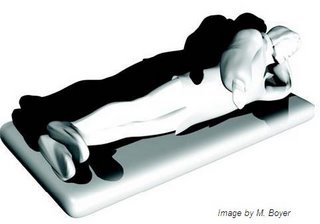 Pick two people off the street at random, put them in a brain scanner, and look at the thickness of their corpus callosums – that’s the massive bundle of nerve fibres that connects the two halves of the brain. In all likelihood, you’ll find it’s much thicker in one person than the other. Indeed, some people can have up to three times as many nerve fibres in their corpus callosum compared with the next person.
Pick two people off the street at random, put them in a brain scanner, and look at the thickness of their corpus callosums – that’s the massive bundle of nerve fibres that connects the two halves of the brain. In all likelihood, you’ll find it’s much thicker in one person than the other. Indeed, some people can have up to three times as many nerve fibres in their corpus callosum compared with the next person.According to Bruce Morton and Stein Rafto, psychologists used to think callosum thickness was largely explained by gender and left or right handedness. For example, one theory had it that men have a thinner connection between their hemispheres, thus causing them to have more specialised brains suitable for maths and the like. But literally hundreds of papers have now been published on the topic and the results have been completely inconsistent – some showing men have thinner hemispheric connectivity, others showing the opposite.
Morton and Rafto think these inconsistent findings are due to the fact callosum thickness is related to hemisphericity – which side of a person’s brain is dominant – irrespective of sex or handedness. To test this, they scanned the brains of 113 participants who also completed several tests of hemisphericity. These look not at handedness, but rather at which side of the brain is dominant. For example, one test measures whether a participant is more accurate at marking the exact mid-point of a line with their left or their right hand.
Morton And Rafto found the thickness of the callosum varied little between the sexes or between the left and right-handers (less than 3 per cent difference in each case), but varied significantly according hemisphericity, with right-brain dominant participants having a 10 per cent thicker callosum on average.
Thickness of the callosum was also independently related to something called ‘dichotic deafness’, a common characteristic of people with a left-hemisphere dominant brain . This is the inability of some people to hear two sounds presented simultaneously, when one sound is played to one ear and the other sound to the other ear. Such people can only hear the sound played to their ‘dominant’ ear, and Morton and Rafto found they too tended to have a thinner corpus callosum.
The results suggest that men and women with a left-hemisphere dominant brain have a thinner corpus callosum and so have less cross-talk between their two hemispheres. Besides dichotic deafness, the practical implications of a thin callosum are unknown. However, it doesn’t seem associated with intelligence – the two participants in this study with the thinnest corpus callosums and the two with the thickest, were all university professors with doctoral degrees.
_________________________________
Morton, B.E. & Rafto, S.E. (2006). Corpus callosum size is linked to dichotic deafness and hemisphericity, not sex or handedness. Brain and Cognition, 62, 1-8.
You have read this article Brain
with the title October 2006. You can bookmark this page URL https://psychiatryfun.blogspot.com/2006/10/the-brain-great-connector.html. Thanks!


























